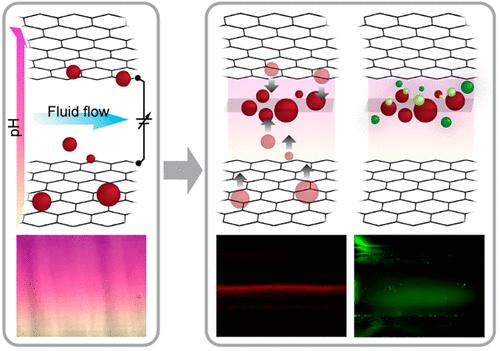Our official English website, www.x-mol.net, welcomes your feedback! (Note: you will need to create a separate account there.)
Graphene-Enabled High-Performance Electrokinetic Focusing and Sensing
ACS Nano ( IF 17.1 ) Pub Date : 2022-06-17 , DOI: 10.1021/acsnano.2c03054 Xiao Fan 1 , Xiaoyu Zhang 1 , Jinglei Ping 1, 2
ACS Nano ( IF 17.1 ) Pub Date : 2022-06-17 , DOI: 10.1021/acsnano.2c03054 Xiao Fan 1 , Xiaoyu Zhang 1 , Jinglei Ping 1, 2
Affiliation

|
Transverse isoelectric focusing, i.e., isoelectric focusing that is normal to the fluid-flow direction, is an electrokinetic method ideal for micro total analysis. However, a major challenge remains: There is no electrode system integrable in a microfluidic device to allow reliable transverse isoelectric focusing and electrokinetic sensing. Here, we overcome this barrier by developing devices that incorporate microelectrodes made of monolayer graphene. We find that the electrolysis stability over time for graphene microelectrodes is >103× improved compared to typical microfabricated inert-metal microelectrodes. Through transverse isoelectric focusing between graphene microelectrodes, within minutes, specific proteins can be separated and concentrated to scales of ∼100 μm. Based on the concentrating effect and the high optical transparency of graphene, we develop a three-dimensional multistream microfluidic strategy for label-free detection of the proteins at same processing position with a sensitivity that is ∼102× higher than those of the state-of-the-art label-free sensors. These results demonstrate the advantage of monolayer-graphene microelectrodes for high-performance electrokinetic analysis to allow lab-on-a-chips of maximal time and size efficiencies.
中文翻译:

石墨烯支持的高性能电动聚焦和传感
横向等电聚焦,即垂直于流体流动方向的等电聚焦,是一种适用于微量全分析的电动方法。然而,一个主要的挑战仍然存在:没有可集成到微流体装置中的电极系统来实现可靠的横向等电聚焦和电动传感。在这里,我们通过开发包含由单层石墨烯制成的微电极的设备来克服这一障碍。我们发现石墨烯微电极的电解稳定性随时间>10 3× 与典型的微制造惰性金属微电极相比有所改进。通过石墨烯微电极之间的横向等电聚焦,可在数分钟内将特定蛋白质分离并浓缩至~100 μm 的尺度。基于石墨烯的聚光效应和高光学透明度,我们开发了一种三维多流微流控策略,用于在同一加工位置对蛋白质进行无标记检测,其灵敏度比状态高约 10 2倍。最先进的无标签传感器。这些结果证明了单层石墨烯微电极在高性能电动分析方面的优势,可实现芯片实验室的最大时间和尺寸效率。
更新日期:2022-06-17
中文翻译:

石墨烯支持的高性能电动聚焦和传感
横向等电聚焦,即垂直于流体流动方向的等电聚焦,是一种适用于微量全分析的电动方法。然而,一个主要的挑战仍然存在:没有可集成到微流体装置中的电极系统来实现可靠的横向等电聚焦和电动传感。在这里,我们通过开发包含由单层石墨烯制成的微电极的设备来克服这一障碍。我们发现石墨烯微电极的电解稳定性随时间>10 3× 与典型的微制造惰性金属微电极相比有所改进。通过石墨烯微电极之间的横向等电聚焦,可在数分钟内将特定蛋白质分离并浓缩至~100 μm 的尺度。基于石墨烯的聚光效应和高光学透明度,我们开发了一种三维多流微流控策略,用于在同一加工位置对蛋白质进行无标记检测,其灵敏度比状态高约 10 2倍。最先进的无标签传感器。这些结果证明了单层石墨烯微电极在高性能电动分析方面的优势,可实现芯片实验室的最大时间和尺寸效率。



























 京公网安备 11010802027423号
京公网安备 11010802027423号